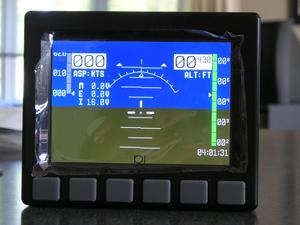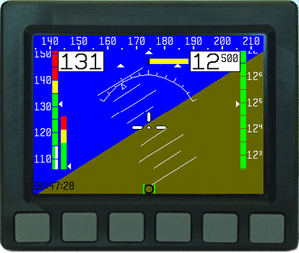Flight Test Data
- Details
- Written by Kevin Horton
- Hits: 3100
The EIS 4000 Engine Information System can output engine data on a serial port in a format that can be recorded by a PC. So I figured I would probably hook that up to record engine data. Recently I bought a Dynon D-10 EFIS, and when I read the Pilot's User Guide, and I learned that it too can output serial data: time, pitch attitude, bank angle, heading, airspeed, altitude, turn rate, lateral and vertical g and angle of attack (if you have the optional angle of attack sensor). I did a bit of research, and it looks like there are fairly cheap add-ons I can buy to allow a laptop to record data from two serial ports.
This evening I managed to record some data from the Dynon EFIS using a laptop computer, so I know it works OK. The data imported into a spreadsheet without too much difficulty, once I figured out that the first line in the data file was corrupt, as it started recording in the middle of a data set. I deleted the first line in a text editor, and the spreadsheet ate it right up. For details on baud rates, etc needed to get the terminal program set up properly, see an earlier posting.
I just realized that the Garmin GNS-430 can put out serial data that a laptop should be able to record too, if I want position, GPS altitude and velocity. I'll be able to swamp the Flight Test Engineers at work with data!
Now I just need to figure out how to record three serial data streams. And the real tricky part will be figuring out how to do a time sync on them, i.e. figure out which record in one data stream occurred at the same time as a record in another data stream.
Dynon Installation
- Details
- Written by Kevin Horton
- Hits: 5330
I've installed the Dynon EFIS in the panel, and it is wired up to the electrical busses. The normal supply is from the Main Bus. If the Main Alternator fails, I'll shed the Main Bus to reduce the electrical load below 8 amps, the rating of the Standby Alternator. The EFIS will automatically switch to its internal battery, which is supposed to be good for two hours. If desired, I have installed a switch that allows the EFIS to get power from the Battery Hot Bus.
The Dynon EFIS Installation Guide also shows a line for Keep Alive power that would be fed from the Battery Hot Bus. This power serves to charge the internal battery and power the clock when the normal power is not supplied. I elected not to connect the Keep Alive power. The internal battery will be charged any time the aircraft is operated anyway, so I see no need to have it charged by the Keep Alive power between flights. I don't care if the clock keeps time or not. I don't want any unswitched power feeding the EFIS, just in case it ever has an internal meltdown that bypasses its built-in power switch. I prefer to be able to remove power from any item, either by turning off a power switch that is external to the unit, or by shutting down power to the bus that feeds the bus.
I've wired up a 1/4 inch stereo jack to provide a way to connect a PC laptop up to the EFIS. Today I wired up a matching cable that goes from a stereo plug to a DB-9 connector that mates up to the laptop serial port. I hooked a borrowed Windows laptop up to the EFIS via the stereo jack and ran the Dynon EFIS-D10 Support Program. The EFIS Support Program recognized the EFIS right away, and I was able to configure the colour ranges on the airspeed tape.
Next I figured out how to record the data stream that the EFIS puts out. Dynon says to use the Windows HyperTerminal program, but it wasn't installed on the borrowed laptop. So I downloaded HyperTerminal PE. It took quite a bit of messing around with different settings to get it to work, but I finally chanced upon the right ones:
| Connect using: | Direct to Com 1 |
| Bits per Second: | 115200 |
| Data Bits: | 8 |
| Parity | N |
| Stop Bits | 1 |
| Flow Control: | None |
I captured the data to a file - it took about 240 KB of data for 1.5 minutes, which should be about 9.5 MB per hour. The data imported into a spreadsheet easily enough, once I had removed the first line in a text editor. There are 64 data records per second, and there doesn't seem to be any way to slow that down to a more reasonable data rate.
Slow progress
- Details
- Written by Kevin Horton
- Hits: 3107
It's been a busy couple of weeks, but I managed to fit in some building. I finished the wheel pants filling and fitting, but I eventually need to fabricate the fairings that go between the wheel pants and the gear leg fairings. The idea of sinking the Tinnerman washers below the surface of the wheel pants looks good so far.
The canopy skirt is almost ready to be riveted to the canopy. I've just got one more small gap between the skirt and fuselage to sort out.
I've also been working on the flight test plan and a Pilot's Operating Handbook (POH) for the aircraft. There are several nice POHs available on the web, so I am using them as a starting point.
Dynon EFIS Arrived
- Details
- Written by Kevin Horton
- Hits: 3471
My Dynon D-10 EFIS arrived today. It would have arrived several days earlier, but UPS only had my office phone number, and I have been out of the office for several days. It is great to finally have the unit in my hands. I can't wait to get it flying.
 I ordered the internal battery option, so I could power the unit up as soon as I pulled it out of the box. It is amazing how quickly the unit powers up. It displays the attitude about 2.5 seconds after power is applied with the unit stationary on a table. It still takes 2.5 seconds if you hold the unit in your hand and move it around slightly as it powers up. The altitude display takes the longest to come on line; it takes about 25 - 30 seconds before it is displayed, at room temperature. I noted one bug - the bank angle pointer is limited to about 65°, even if the actual bank angle is greater than that. I suspect Dynon knows about this one already, but I sent them an e-mail just in case they aren't aware of it.
I ordered the internal battery option, so I could power the unit up as soon as I pulled it out of the box. It is amazing how quickly the unit powers up. It displays the attitude about 2.5 seconds after power is applied with the unit stationary on a table. It still takes 2.5 seconds if you hold the unit in your hand and move it around slightly as it powers up. The altitude display takes the longest to come on line; it takes about 25 - 30 seconds before it is displayed, at room temperature. I noted one bug - the bank angle pointer is limited to about 65°, even if the actual bank angle is greater than that. I suspect Dynon knows about this one already, but I sent them an e-mail just in case they aren't aware of it.
This photos shows the display with the factory defaults. Each of the various display items can be selected to be displayed, or not displayed. I will definitely select some of the default items OFF to unclutter the display a bit. The voltages (below the airspeed digital readout) and the clock (below the altitude tape) will be switched OFF. The altitude tape will probably be switched OFF too.
I just noted that the heading tape wasn't displayed at the top of the screen. I'll need to look into that tomorrow. Perhaps it is not displayed by default, or perhaps it isn't displayed until you do the calibration routine on the flux valve, or perhaps mine is set up to not display unless the remote flux valve is hooked up, as I ordered that option.
 It slipped into the instrument panel nicely, after I spent a few minutes with a needle file tweaking two of the screw holes slightly. I drilled the screw holes myself, so they are likely not quite perfectly positioned. I need to make up a wiring harness for it, order so pitot-static fittings and finish the installation.
It slipped into the instrument panel nicely, after I spent a few minutes with a needle file tweaking two of the screw holes slightly. I drilled the screw holes myself, so they are likely not quite perfectly positioned. I need to make up a wiring harness for it, order so pitot-static fittings and finish the installation.
The display is shipped with a clear plastic sheet over it to protect if. I'll leave that on there until I am getting ready for the first flight.
I originally planned to have a directional gyro below the attitude indicator. I won't need the DG if the heading display works properly, so I'll likely move the CDI up one spot. If the EFIS proves to be a keeper I'll order a new instrument panel blank and make a new one without the removable panel in the centre, as I won't need to remove the EFIS before doing aerobatics as I intended to do with the electric gyros.
Instrument Panel Layout
- Details
- Written by Kevin Horton
- Hits: 1577
The various iterations of the instrument panel design are shown below:
Dynon D-10 EFIS Evaluation
- Details
- Written by Kevin Horton
- Hits: 4857
 Comments on Dynon D-10 EFIS - I performed a short evaluation flight on a Dynon D-10 EFIS with software 1.04.00, installed in Mark Nielsen’s RV-6, N121MN. The flight was from Green Bay on July 28, 2003. I had previously ordered the Dynon EFIS, but I wanted to evaluate it in flight before confirming the order. In summary, I will confirm my order, but there are some aspects of the display and user interface that should be improved. The following comments were forwarded to Dynon for their consideration.
Comments on Dynon D-10 EFIS - I performed a short evaluation flight on a Dynon D-10 EFIS with software 1.04.00, installed in Mark Nielsen’s RV-6, N121MN. The flight was from Green Bay on July 28, 2003. I had previously ordered the Dynon EFIS, but I wanted to evaluate it in flight before confirming the order. In summary, I will confirm my order, but there are some aspects of the display and user interface that should be improved. The following comments were forwarded to Dynon for their consideration.
Read on for more.
